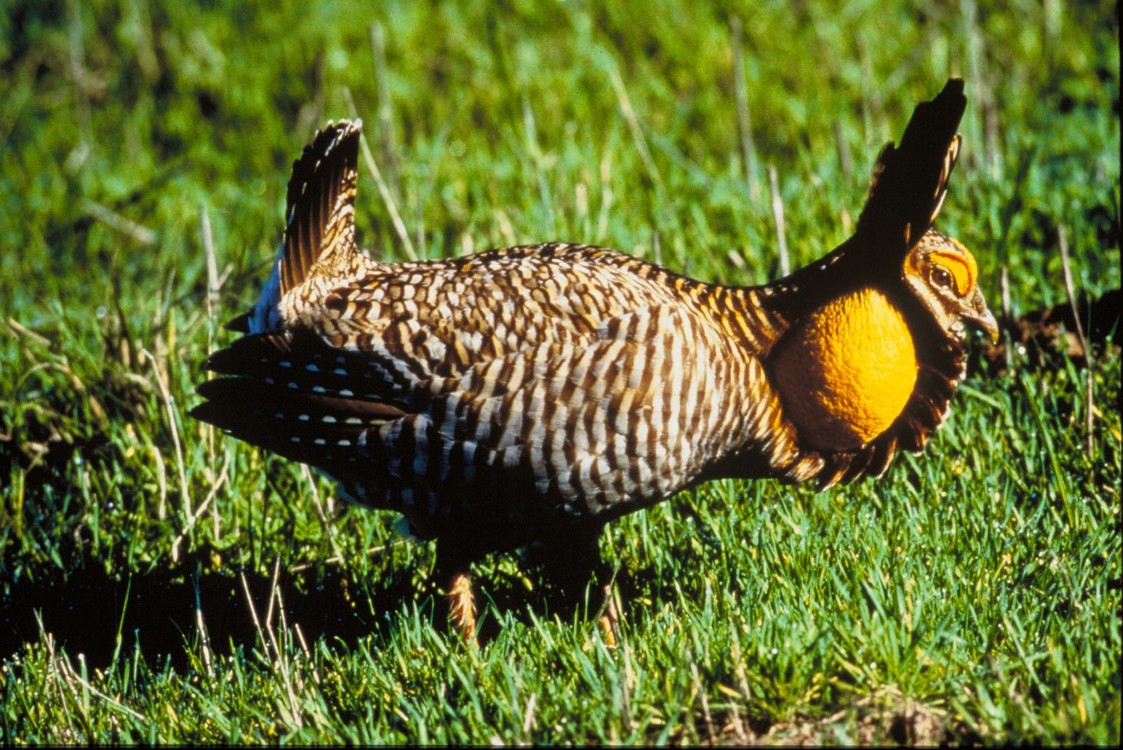- Attwater's Prairie Chicken
Taxobox
name = Attwater's Prairie Chicken
status = EN | status_system = IUCN3.1

regnum =Animal ia
phylum = Chordata
classis = Aves
ordo =Galliformes
familia =Tetraonidae
genus = "Tympanuchus "
species = "T. cupido"
subspecies = "T. c. attwateri"
trinomial = "Tympanuchus cupido attwateri"
trinomial_authority =Attwater's Prairie Chicken ("Tympanuchus cupido attwateri") is a highly endangered subspecies of prairie chicken related to the now extinct
heath hen .Over a century ago, one million Attwater's Prairie Chickens graced the
Texas andLouisiana gulf coastalprairie . Today, less than 1% of their native coastal prairie habitat remains and in 1998 it was estimated that only 260 remained, with less than 60 living in the wild. Their sole refuges in the wild are theAttwater Prairie Chicken National Wildlife Refuge nearEagle Lake, Texas and another tiny parcel of land that was set aside nearTexas City . There is also a small captive breeding colony residing on the grounds of theNASA Lyndon B. Johnson Space Center nearClear Lake, Texas . Captive breeding programs are underway at places such asFossil Rim Wildlife Center [http://www.fossilrim.org] ,Texas A&M University ,Seaworld of Texas, and theHouston Zoo [http://houstonzoo.org] .The Attwater's Prairie Chicken measures 17-18 inches (43-45.5 cm) and weighs roughly 1.5 to 2 pounds (0.7 to 0.9 kg). It has a 28 inch (70 cm) wingspan. These grouse-like ground birds have strong vertical bars of dark brown and buff-white in a zebralike pattern over the mantle, flanks, and underparts. The species exhibits
sexual dimorphism , with the males having elongated feathers, called pinnae, erected to form earlike structures. The male also has as a bright orange to reddish air sac on either side of his neck, which he inflates during mating displays.The mating display can be seen in January or February when the birds gather in small groups on short grass, bare ground, rock outcroppings or hilly areas in order to choose a mate. This area is called a "booming ground" or a "lek". In these areas, the females watch the males and choose their mate. The male emits a booming, "woo-woo" sound from his throat sac and struts around to attract a female. Some of the traditional dances of the North American Plains Indians, notably those of the Lakota, are based on this booming display. Later, the hens build grass nests on the ground, hidden in tall grass, where they lay their eggs.
The bird has a diverse diet, eating leaves, seeds, and insects such as
grasshopper s. Their predators includeRed-tailed Hawk s,owl s,coyote s,raccoon s,skunk s, Opossum, andsnake s. Many young birds also die from causes such as flooding.Loss of habitat is believed to be the prime reason for their downfall. There was once 6 million acres (24,000 km²) of coastal prairie, now there is less than 200,000 acres (800 km²). In addition to loss due to urbanization, the entire prairie ecosystem where they once thrived no longer exists in the same form. Where once grazing bison and periodic fires due to lightning reduced ground cover, the birds now have difficulty making their way through thick undergrowth. It is possible that other less-apparent changes in the ecosystem have had an effect as well.
Attwater's Prairie Chicken has been on the
endangered species list since March 1967.External links
* [http://southwest.fws.gov/refuges/texas/attwater/index.html Attwater Prairie Chicken National Wildlife Refuge]
* [http://www.tpwd.state.tx.us/huntwild/wild/species/apc/ Texas Parks and Wildlife on the Attwater's Prairie Chicken]
* [http://magma.nationalgeographic.com/ngm/data/2002/03/01/html/ft_20020301.3.html National Geographic Article]
* [http://www.fossilrim.org/research/attwater.php Fossil Rim Wildlife Center]
* [http://www.tsha.utexas.edu/handbook/online/articles/view/PP/tbp2.html Handbook of Texas Online]
* [http://www.houstonzoo.org/PrairieChicken/ Houston Zoo]
Wikimedia Foundation. 2010.
